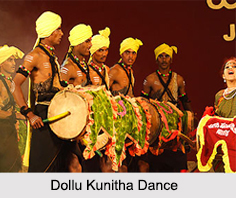 Dollu Kunitha provides both spectacular variety and complexity of skills in the process of demonstration. It is performed in order to please the deity of Beereshwara or Beeralingeswara, worshipped by the Kuruba Gowdas of Karnataka and Andhra Pradesh, also called Halumathasthas.
Dollu Kunitha provides both spectacular variety and complexity of skills in the process of demonstration. It is performed in order to please the deity of Beereshwara or Beeralingeswara, worshipped by the Kuruba Gowdas of Karnataka and Andhra Pradesh, also called Halumathasthas.
In all temples where deity Beereshwara presides, it is a religious practice that the major instrument Dollu be hung in the premises of the temple through a thick thread tied up to the hooks fixed in the ceiling. Every time pooja is offered to Beereshwara, as per the custom there should be an instantaneous beating of the Dollu as an accompanying act of worship. The districts of Shimoga and Chitradurga are noted for their excellence in the performance of this dance. Not only a mode of entertainment but it is also intended towards the spiritual well being of the performers and the spectators.
History of Dollu Kunitha
Kuruba Gowdas sings to praise lord Beereshwara, giving an altogether different ring of intonation. Their singing traces the origin of their genealogy, evolution and development over the ages. This expressive literature in its oral tradition goes by the legend called `Halumatha Purana` or Kuruba Purana.
Tradition of Dollu Kunitha
Dollu dance has gained importance with time. No religious performance of a ritualistic ceremony or any village festival can take place without this dance, especially in North Karnataka. The Dollu dance becomes the very centre of activity around which other important things get built up. Well built sturdy people can perform this dance as it requires strength, muscle power and the spirit of endurance. The themes were religious and were known as the `Halumatha Purana` or simply the `Kuruba Purana`. Recently it has been used to propagate various government schemes and programs. It is used to welcome the harvest season. It can be arranged to commemorate a wedding, the birth of a child or even a burial or a funeral.
Legends of Dollu
A demon Dollasura worshiped Lord Shiva. Lord Shiva appeared before him and asked him to ask for a boon, Dollasura asked that he should be able to swallow Lord Shiva. The boon was granted and Dollasura swallowed Shiva. Shiva started growing bigger. The asura was unable to bear the pain and pleaded Shiva to come out. Shiva killed him and came out; Shiva used the skin of the "ashura" to make a drum and gave it to the rustics to play it.
Performance of Dollu Kunitha
The performers form a semi-circle and involve in extremely swift and supple movements. The beat is controlled and directed by a leader with cymbals who is positioned in the centre. Slow and fast rhythms alternate and group weaves varied patterns. The costumes are simple. Upper part of the body is usually left bare while a black sheet-rug is tied on the lower body over the `dhooti` or sarong.
The other forms of this dance are Devare Thatte Kunitha, Yellammana Kunitha, Suggi Kunitha and Alagu Kunitha etc. These dances are named after the deity or the symbol or instruments which are balanced on the head or held in the hand of the dancer. Puja Kunitha is another form of dance. In this dance form the dancers carry a wooden structure having a deity on their heads. The Pata Kunitha, the Gorava Kunitha and the Kamsale are some of the other common ritualistic dances.



















